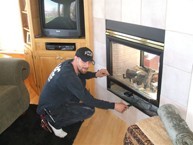Chimney sweeping evokes images of cockney street urchins, stovepipe hats and Dick Van Dyke. But the principles involved haven’t changed in 150 years, and while today’s chimney sweeps use modern equipment and techniques, the work they do isn’t all that different from those of their predecessors. Chimney sweeping in St. Paul is a particular necessity, owing to our numerous older homes with fine brick fireplaces.
The benefits of chimney sweeping are numerous and obvious.
- Safety. Smoke from your fireplace carries creosote into the chimney, which can coat the walls and ultimately become a fire hazard (it will ignite very easily). Creosote build-up can also prevent carbon monoxide from escaping your home, constituting another hazard.
- Comfort. Build up inside the chimney can prevent smoke from escaping as quickly as it should, meaning that more of it could back up into your home. Clean chimneys also improve the amount of heat your fireplace projects into your home, making it more efficient as well as comfortable.
- Longevity. Over time, the acidic qualities of soot and other debris can damage your chimney, forcing expensive and unnecessary repairs. A regular cleaning session can prevent that damage and extend the life of your chimney.
A good chimney sweeper understands the benefits of chimney sweeping, but also knows who to deliver them safely and effectively. That means paying close attention to new methods and techniques. Qualified chimney sweeps are licensed, bonded and insured to protect against accidents. They also work with the cleanliness of your home in mind, and guarantee their work once it’s completed.
For chimney sweeping in St. Paul, the professionals at 2nd Generation Chimneys, Inc. are ready to help. We’ve served the Twin Cities area since 2001 and offer complete programs for inspecting, installing and maintaining your chimney. We’re available 24 hours a day in the event of emergencies, and our trained experts have earned the trusted of over 52,000 loyal customers. If you understand the benefits of chimney sweeping and want to set up a regular maintenance session to help keep yours clean, pick up the phone and give us a call today.

